Patee Town Historic District is a national historic district located at St. Joseph, Missouri. The district encompasses 71 contributing buildings and 1 contributing site in the Patee Town section of St. Joseph. It developed between about 1858 and 1939, and includes representative examples of Greek Revival and Italianate style architecture. Located in the district are the separately listed Patee House, a hotel that is a U.S. National Historic Landmark, and Jesse James House. Other notable buildings include the Morey Piro House (1910), Charles E. Herycele House (1903), R. L. McDonald Manufacturing Co. Warehouse (1899), Mrs. Pemetia Cornish Duplex, Fred Wenz Store Building (1903), Fire Station #5 (1939), German Salems Church, and Matthew Ziebold House (1895).

The St. Charles Historic District is a national historic district located at St. Charles, St. Charles County, Missouri. It is the site of the first permanent European settlement on the Missouri River and of the embarkation of Lewis and Clark's journey of exploration along the Missouri. The first state capital of Missouri and over one hundred other historic buildings are located in the district.

Edmond J. Eckel was an architect in practice in St. Joseph, Missouri, from 1872 until his death in 1934. In 1880 he was the founder of Eckel & Mann, later Eckel & Aldrich and Brunner & Brunner, which was the oldest architectural firm in Missouri prior to its eventual dissolution in 1999.

Dr. Jacob Geiger House-Maud Wyeth Painter House, also known as the United Missouri Bank, is a historic home located at St. Joseph, Missouri. It was designed by the architecture firm of Eckel & Aldrich and built in 1911–1912. It is a 2+1⁄2-story, Gothic Revival style masonry building with a three-story crenellated tower and a two-story crenellated tower. It features an arcaded porch and a four-bay bow window with gargoyles. The house has been converted for commercial uses.
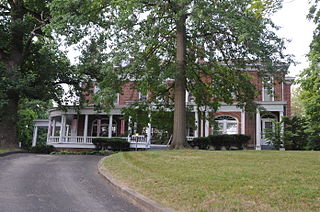
Miller-Porter-Lacy House, also known as the Lacy House, is a historic home located at St. Joseph, Missouri. The original section was built in 1883, as an Italianate style brick farmhouse. It was enlarged and remodeled in 1902 by the architect Edmond Jacques Eckel (1845–1934) in the Colonial Revival / Georgian Revival style. It is a large brick dwelling with a low hipped roof. It features Tuscan order columned porches and a porte cochere. Also on the property is a contributing carriage house and croquet and tennis court sites.
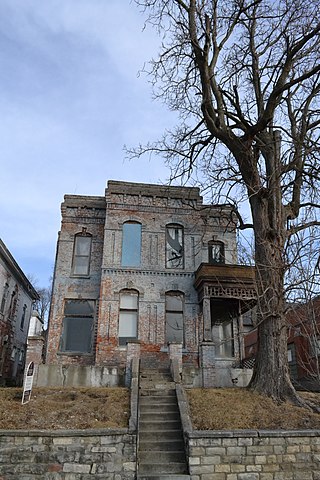
Cathedral Hill Historic District is a national historic district located at St. Joseph, Missouri. The district encompasses 309 contributing buildings, 1 contributing site, and contributing structures in a predominantly residential section of St. Joseph. It developed between about 1860 and 1950, and includes representative examples of Greek Revival, Italianate, Queen Anne, Colonial Revival, and American Craftsman style architecture. Located in the district is the separately listed Virginia Flats. Other notable buildings include the Nisen Stone House, Thomas Culligan House, A. D. Hudnutt House (1909), St. Joseph Cathedral (1877), James Wall House, Taylor Apartments, E. F. Weitheimer House (1888), Sarah and Ann Walsh Apartment House (1915), Henry Owen Stable (1898), George T. Hoagland Speculative House (1901), and James Hull House (1887).

Dewey Avenue–West Rosine Historic District is a national historic district located at St. Joseph, Missouri. The district encompasses 37 contributing buildings and 1 contributing site in a predominantly residential section of St. Joseph. It developed between about 1880 and 1930, and includes representative examples of Italianate, Second Empire, Queen Anne, Colonial Revival, Tudor Revival, and American Craftsman style architecture. Notable buildings include the Marshall B. Stroud House (1890), John and Frank Whitman House (1890), Johanna Johnson House (1908), Frank Lacy House (1900), and a number of speculative houses built by Charles H. Nowland.

Harris Addition Historic District is a national historic district located at St. Joseph, Missouri. The district encompasses 288 contributing buildings and 1 contributing site in a predominantly residential section of St. Joseph. It developed between about 1866 and 1940, and includes representative examples of Colonial Revival, Tudor Revival, and American Craftsman style architecture. Notable buildings include the William Payne House (1889), W.C. Green Apartment Building, C.B. Powers House, the Parry-Motter House designed by architect Edmond Jacques Eckel (1845–1934), and a number of speculative houses built by George J. Englehart and W.H. Haynes.

Kemper Addition Historic District is a national historic district located at St. Joseph, Missouri. The district encompasses 74 contributing buildings and 1 contributing site in a predominantly residential section of St. Joseph. It developed between about 1880 and 1950, and includes representative examples of Colonial Revival, Tudor Revival, and American Craftsman style architecture. Notable buildings include the Jacob Spencer House (1912), H. E. Hutchings House (1887), Fred Binz House, Thomas Moseley Duplex (1894), Plaza Apartments (1928-1929), Hickey-Fargrave House with alterations by architect Edmond Jacques Eckel (1845–1934),`C. E. Sprague House (1905) by Eckel, David Bartlett House (1900) by Eckel, and Samuel Nave House (1889).

St. Joseph's Commerce and Banking Historic District is a national historic district located at St. Joseph, Missouri. The district encompasses 39 contributing buildings in the central business district of St. Joseph. It developed between about 1859 and 1950, and includes representative examples of Italianate, Classical Revival, and Streamline Moderne style architecture. Located in the district are the separately listed German-American Bank Building, Corby-Forsee Building, Missouri Theater and Missouri Theater Building, and Missouri Valley Trust Company Historic District. Other notable buildings include the Ballinger Building (1889), Commerce Building, First National Bank of St. Joseph, Lehman's, Plymouth Building (1908), and the United Building (1917-1918) by the architecture firm of Eckel & Aldrich.

Central-North Commercial Historic District is a national historic district located at St. Joseph, Missouri. The district encompasses 18 contributing buildings in an industrial / commercial section of St. Joseph west of the central business district. It developed between about 1885 and 1929, and includes representative examples of Italianate and Classical Revival style architecture. Located in the district is the separately listed John D. Richardson Dry Goods Company. Other notable buildings include a number of warehouse / light manufacturing facilities some of which were designed by the architectural firm of Eckel & Aldrich.
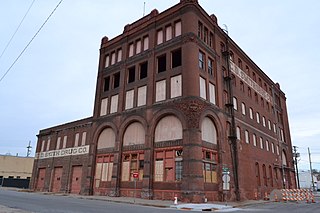
South Fourth Street Commercial Historic District is a national historic district located at St. Joseph, Missouri. The district encompasses 25 contributing buildings in an industrial/commercial section of St. Joseph west of the central business district. It developed between about 1861 and 1929, and includes representative examples of Italianate, Classical Revival, and Renaissance Revival style architecture. Notable buildings include a number of commercial blocks and warehouse/light manufacturing facilities some of which were designed by architect Edmond Jacques Eckel (1845–1934).
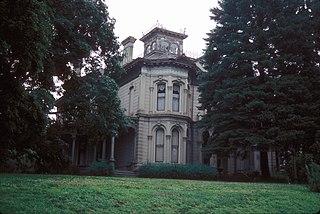
Robidoux Hill Historic District is a national historic district located at St. Joseph, Missouri. The district encompasses 61 contributing buildings in a predominantly residential section of St. Joseph. It developed between about 1865 and 1909, and includes representative examples of Italianate, Second Empire, and Queen Anne style architecture. Located in the district is the separately listed Edmond Jacques Eckel House designed by architect Edmond Jacques Eckel (1845–1934). Other notable buildings include the Lemon House (1871), Donovan House, McKinney House (1887), Inslee House, Jonathan M. Bassett, and U.S. Weather Bureau Building (1909).
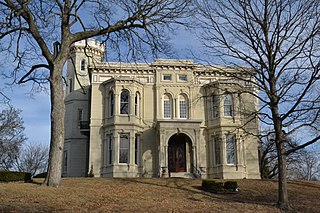
Museum Hill Historic District is a national historic district located at St. Joseph, Missouri. The district encompasses 248 contributing buildings in a predominantly residential section of St. Joseph. It developed between about 1860 and 1942, and includes representative examples of Italianate, Second Empire, Queen Anne, Tudor Revival, American Foursquare, and Bungalow / American Craftsman style architecture. Located in the district is the separately listed Robidoux School. Other notable buildings include the First Congregational Church (1890), Francis Street Methodist Church (1905), First Baptist Church (1896) designed by architect Edmond Jacques Eckel (1845–1934), United Presbyterian Church (1901), First Church of Christ Scientist (1905), First English Evangelical Lutheran Church (1913), and Queen of the Apostles Roman Catholic Church (1908) designed by Eckel.

Wholesale Row, also known as the Wholesale Row Historic District, is a national historic district located at St. Joseph, Missouri. The district originally encompassed five contributing buildings in an industrial / commercial section of St. Joseph on the western edge of the central business district. The Noyes-Norman Building (1872) on 3rd Street has been demolished. It developed between about 1872 and 1884, and includes representative examples of Italianate style architecture. The remaining buildings are the R.L. McDonald and Co. Building (1880), Englehart-Winning Co. North Building (1884), Englehart-Winning Co. South Building (1880), and Brittain-Richardson and Co. Building (1882). The remaining buildings were all designed by the architect Edmond Jacques Eckel (1845–1934).
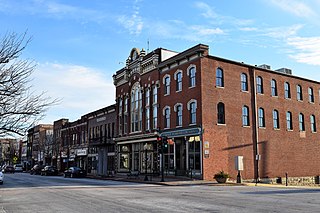
Missouri State Capitol Historic District is a national historic district located at Jefferson City, Cole County, Missouri. It encompasses 122 contributing buildings in the central business district of Jefferson City. The district developed between about 1850 and 1950, and includes representative examples of Classical Revival, Late Victorian, Queen Anne, Mission Revival, and Modern Movement style architecture. Located in the district are the separately listed Missouri State Capitol, Lohman's Landing Building, Cole County Historical Society Building, Cole County Courthouse and Jail-Sheriff's House, Missouri Governor's Mansion, and Tergin Apartment Building. Other notable buildings include the St. Peter's Roman Catholic Church complex (1881-1883), Margaret Upshulte House, Broadway State Office Building (1938), Supreme Court of Missouri (1905-1906), U.S. Post Office and Courthouse (1932-1934), Lohman's Opera House, Missouri State Optical, First United Methodist Church (1900), Carnegie Public Library (1901), Temple Beth El (1883), and Joseph and Susie Kolkmeyer House.
Fayette Residential Historic District is a national historic district located at Fayette, Howard County, Missouri. The district encompasses 308 contributing buildings and 2 contributing structures in a predominantly residential section of Fayette. It developed between about 1832 and 1956 and includes representative examples of Gothic Revival, Italianate, and Queen Anne style architecture. Located in the district is the separately listed Coleman Hall. Other notable buildings include the Hampton L. Boon House / George Carson House, W. W. Blakemore House, John Sears House / John B. Clark House, McKinney Sisters House, Tully Chenowith House, Methodist Episcopal Parsonage, T. A. F. Mitchell House, Oliver H. P. Corprew House (1880s), Huntington Hall, A. F. Davis House (1880-1884), R. Lee Maupin House (1905), Mrs. John H. Farrington House, the Daly School (1924), the T. A. Grigsby Building, and St. Joseph's Catholic Church (1956).

Courthouse Square Historic District is a national historic district located at West Plains, Howell County, Missouri. The district encompasses 46 contributing buildings in the central business district of West Plains. It developed between about 1881 and 1950 and includes representative examples of Italianate, Queen Anne, Romanesque Revival, Late Gothic Revival, and Art Deco style architecture. Located in the district are the separately listed Elledge Arcade Buildings, W. J. and Ed Smith Building, and West Plains Bank Building. Other notable buildings include the IOOF Building #2, First Presbyterian Church, Howell County Courthouse (1937), Aid Hardware Building (1914-1915), W. N. Evans Building, J. R. Foster Building, Foster-Renfrew Building, Alsup, Risley & Skillman Block, Catron Opera House / Johnson Opera House (1893), IOOF Building / J. R. Galloway Building (1896), Evans Theatre, W. J. Zorn Building, #1/Howell County Gazette Building (1911-1912), West Plains Fire Department/City Hall (1917), and Avenue Theatre (1950).

North Third Street Historic District is a national historic district located at Louisiana, Pike County, Missouri. The district encompasses 61 contributing buildings, one contributing site, and contributing structure in a predominantly residential section of Louisiana. It developed between about 1843 and 1935 and includes representative examples of Greek Revival, Gothic Revival, Italianate, Queen Anne, Colonial Revival, and Bungalow/American Craftsman style architecture. Located in the district are the separately listed Louisiana Public Library and Luce-Dyer House. Other notable buildings include the William C. Hardin House, James H. Johnson House, Edward G. McQuie House, St. Joseph's Catholic Church (1874), and Frank Boehm, Jr. House.

The White Cloud Historic District is a 41.3 acres (16.7 ha) historic district in White Cloud, Kansas which was listed on the National Register of Historic Places in 1996. It is roughly bounded by Poplar, 6th, Chesnut Sts. and K-7 and included 67 contributing buildings and a contributing site, as well as 15 non-contributing buildings and a non-contributing site.






















